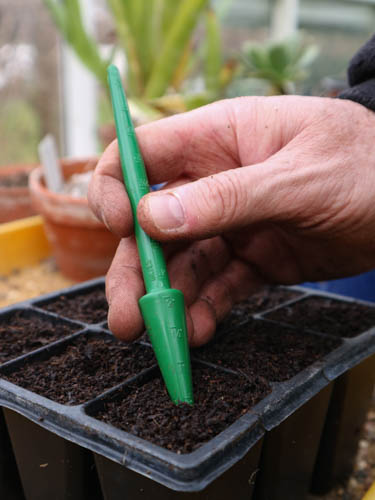
March usually says ‘Farewell’ to winter and ‘Hello’ to spring, a transition that seems to herald a month of erratic weather. I start sowing outdoors after warming the soil then add a few ‘back ups’’ under glass to fill the gaps if germination is erratic. In northern or cooler locations, you can also start sowing in the greenhouse to get one step ahead of the weather.
Parsnips and carrots can be sown in modules – they resent root disturbance but can be transplanted at the final spacing before the roots become too large. You can sow them from early in the month in the cardboard centres from toilet rolls or kitchen towels cut to the same length (the latter are more hygienic) or placed vertically in seed trays and filled with peat free multipurpose compost. (some gardeners sow earlier, from early to mid-February). Sow three seeds per tube and thin to leave the strongest. I also sow some round rooted beetroot and carrots around the edge of a 7.5cm pot (or a similar size), for later ‘hardening off’ and transplanting. Thin as required and harvest when they reach the size of a golf ball. Once planted, they develop like eggs in a nest.
Peas can be sown in pots, ‘root trainers’ or sections of guttering cut to a manageable length – usually the width of the bed, in peat free multipurpose compost in a repeat pattern of a 5 on a dice. It is time to transplant when the seedlings are 5-7.5cm high, water the compost well, then starting at one end of the drill and moving towards the other end of the drill, slide the peas and compost gently down into a shallow pre-dug trench and gently firm. Adding a little detergent to the water helps the compost slide down smoothly. It is also worth sowing a few leaves like lettuces, spinach, salad leaves in pots, trays or modules as a backup, too.
If you have not yet done so, sow tomatoes, sweet peppers and aubergines and put them in the propagator early in the month.
Later in the month tender fuchsias can be woken from their winter rest. Mist with tepid water once or twice a day. When the first shoots appear, give them a little tepid water, increasing the amount as more growth appears. Spraying the stems with tepid water softens the bark and helps the new shoots to emerge.
It’s also time to encourage tuberous begonias into growth. Put them in trays in a mix of equal parts John Innes no2 and peat free multipurpose, with the concave side uppermost. Water them in with a tepid water/fungicide solution, then cover with a sheet of newspaper and keep around 16-18C (60-65 deg F). Once the first shoots appear, remove the newspaper and keep them in the shade. If you can’t provide heat, wait until late April and start them off in a cool greenhouse.
When Citrus, like my Yuzu lime, start into growth, increase watering using tepid rainwater and give them a boost with citrus summer feed once they get going. Happy gardening. Stay safe, Matt


